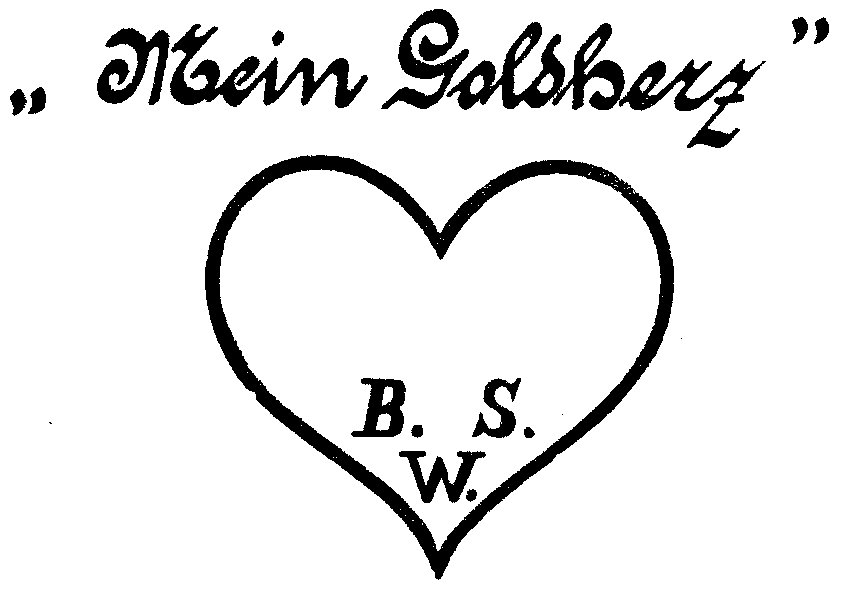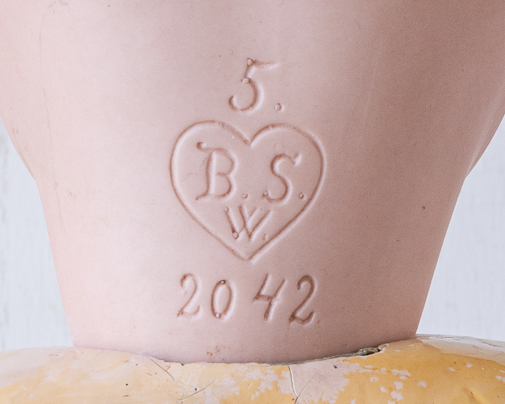Bruno Schmidt Doll Marks

In 1904 Bruno Schmidt applied to register the trademark of a heart with the letters BSW in the lower part of the heart and the words Mein Goldherz above it. It was registered as a WORD/Figurative mark. The trademark registered on November 1, 1904 under the old number of SCH6874 but is now under the registered number of DD73494. The proprietor of the trademark was listed as “Bruno Schmidt KG Gummi- und Celluloidwarenfabrik, 99880 Waltershausen, DE.” View the mark at the DPMA.de here.
Another trademark was registered under the number SCH10064 in 1908 but the image file was destroyed and is not viewable at the DPMA.de. The mark was only a figurative mark, possibly the heart arranged differently than the 1904 mark.
March 6 of 1933 Bruno Schmidt registered the word mark “HERZ”
Leipzig Trade Fair Address Book Listings
In 1900 the Offizielles Leipziger Mess-Adressbuch (Official Leipzig Trade Fair Addressbook) gave a listing for Bruno Schmidt’s company. The listing reads, (translated) “Schmidt, B., formerly B. Schmidt, formerly H. Geisler & Co., Waltershausen (Thuringia), Bruyère pipes. O.-V. and M. Department store, 2nd floor, hall, stand 164” or “Schmidt, B., früher B. Schmidt, vorm. H. Geisler & Co., Waltershausen (Thür.), Bruyère-Pfeifen. O.-V. u. M. Kaufhaus, II. Obergeschoss, Saal, Stand 164.”
The Bruno Schmidt listing in 1905 mentions both the pipe factory and the doll factory. “Schmidt, B., Waltershausen/Thür., pipe factory and doll factory. Second floor, hall, stand 193/94.”
The Schmidt listing in the address book for 1906 reads, “Schmidt, Bruno, Waltershausen (Thuringia), doll factory, special: ball-jointed dolls. O.-V. u. M. Department store, 2nd floor, hall, stand 193.” The following year in 1907 reads rather much the same.
The Official Leipzig Trade Fair Addressbook in 1910 listed, “Schmidt, Bruno, Waltershausen, – Kaufhaus II, Saal, Std. 193/194.”
Bruno Schmidt Owns Baehr & Proeschild
In 1918 The Keramische Rundschau announced, “Change of ownership. The Baehr & Proeschild porcelain factory in Ohrdruf has been transferred to the doll manufacturer Bruno Schmidt in Waltershausen.” Bruno Schmidt continued the business under the name Baehr & Proeschild.
1919 Patent
Schmidt’s 1919 patent reads, “REICHSPATENT OFFICE PATENT LETTER No 322503, CLASS 39a, GROUP 15. Bruno Schmidt in Waltershausen i. Thür. Process for producing hollow bodies from celluloid. Patented in the German Reich from July 17, 1919.”
The body of the patent (translated) was as follows:
In the manufacture of hollow bodies from celluloid sheets or tubes, for example in doll manufacture, the blowing out, namely the application of the mass to the mold, takes place by blowing steam between the celluloid sheets placed on top of each other after the upper half of the mold has been placed on the lower half, whereby the upper half of the mold initially sinks into the material of the celluloid sheets due to its own weight and is then pressed firmly against the lower half of the mold by means of the stamp of a press. This process produced very useful products when using the good material available before the outbreak of war, which consisted of pure Japanese camphor and cellulose, as this peacetime material had a fairly high elasticity, which ensured that the mass could be applied properly to the various elevations and depressions of the mold and also enabled the two pieces of material to be properly butted together by pressing the edges of the mold into the material of the plates. However, when processing the so-called war material, which is made using substitute materials, it was found that an extraordinary number of defective products were produced, as the less elastic material was not able to fit tightly to the molds everywhere and the edges burned, initially causing bubbles to form on the edges, which lead to holes being formed when the mold is blown out further.
These defects are now eliminated by the new process that forms the subject of the invention. The invention essentially consists in the fact that the upper half of the mold is not simply left to the influence of its own weight as before, but is initially held at a distance from the lower half of the mold by means of cushioning, which corresponds exactly to the thickness of the two material plates placed on top of each other, after which a pre-blowing takes place, so far that the material first adapts to the larger unevenness (depressions and elevations) in the interior of the mold, in order to be blown to completion only after the press ram has been lowered and after the two mold halves have been brought into contact with each other. By initially keeping the upper half of the mold at a distance from the contact surface of the lower half of the mold by the aforementioned distance, the material is given the opportunity to give way during pre-blowing or to be able to insert itself into the cavities of the mold without any bubbles forming at the edges, while maintaining the intimate contact of the two celluloid plates, despite the lack of elasticity of this war material. This also avoids the occurrence of holes at the edges, which has previously been so extremely common, and the considerable success has been achieved in that the waste is limited to approximately the amount that would have been expected when processing the good and elastic peacetime material using the usual method.
The drawing illustrates the device used to carry out the new method in an example.
Fig. 1 is a plan view of the lower half of the mold, while Fig. 2 shows, on an enlarged scale compared to Fig. 1, a side view of part of the new mold in the position in which the pre-blowing of the material is carried out.In the drawing, a is the lower half of the mold for producing a doll part, with the known guide pins b for guiding the upper half of the mold c being arranged at the four corners of the mold. While in the previously used method the upper mold half c was simply placed on the guide pins b and then left to the effect of its own weight, in the subject matter of the invention resilient means are provided which are to be dimensioned or arranged in such a way that they are able to absorb the entire weight of the upper mold half c or a part of this weight in such a way that the upper mold half c, after being placed on the guide pins b, rests against the surface of the upper celluloid plate without any pressure being exerted and without being pressed in. In the illustrated embodiment, springs d are arranged around the guide pins b for this purpose, which form an eyelet d1 at one end, by means of which they can be attached to the lugs e, e of the lower half 35, the tension of these springs d being such that the upper mold half c, after being placed on the guide pins b of the lower mold half, is held above the latter at a distance which corresponds to the thickness of the two celluloid plates placed on top of each other or twice the thickness of the material. These springs d act as long as the pre-blowing of the material lasts, but they give way as soon as the stamp of the press in which the mold is.
German Patent and Trademark Office, July 1920. Document DE000000322503A.
